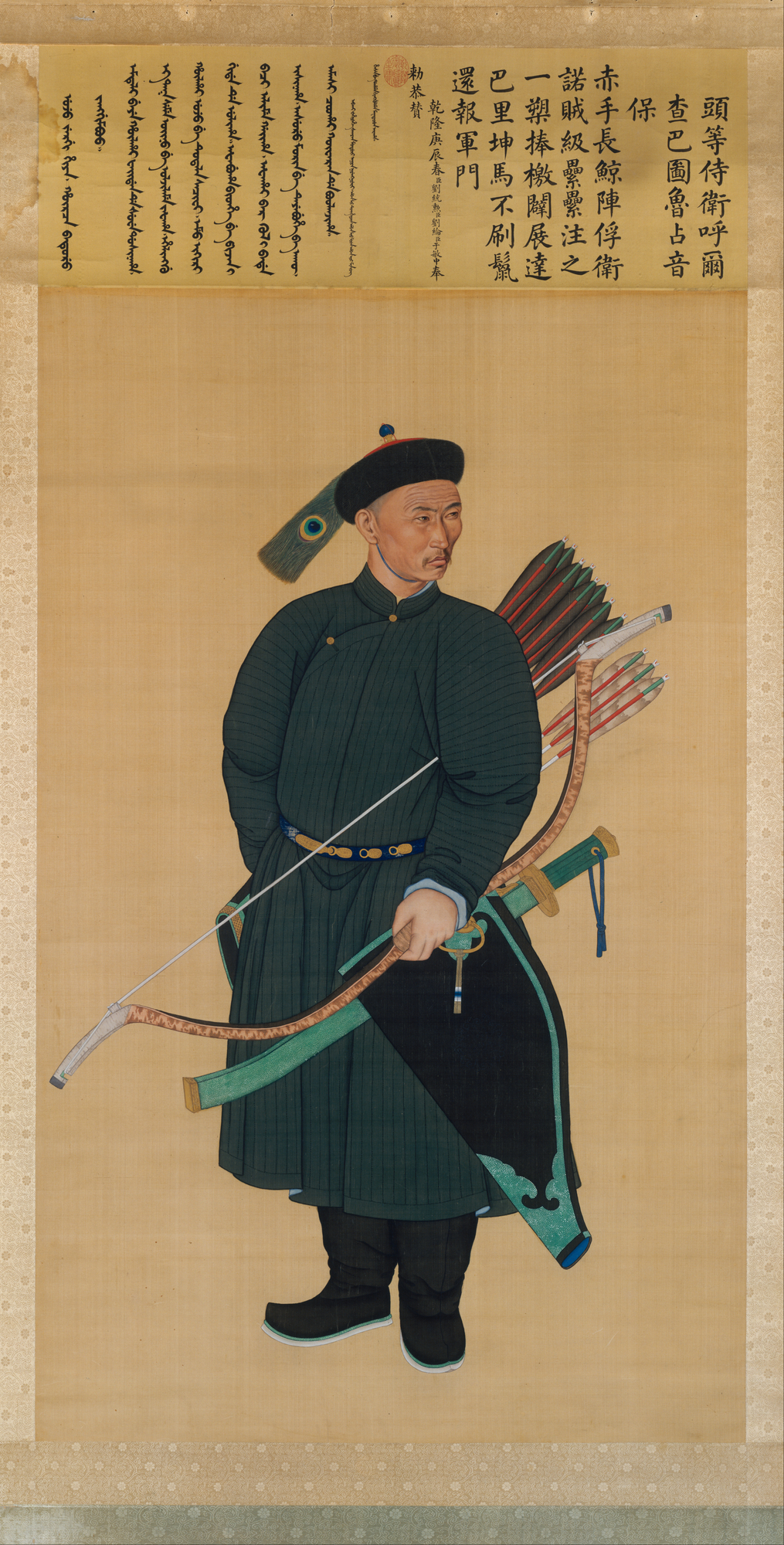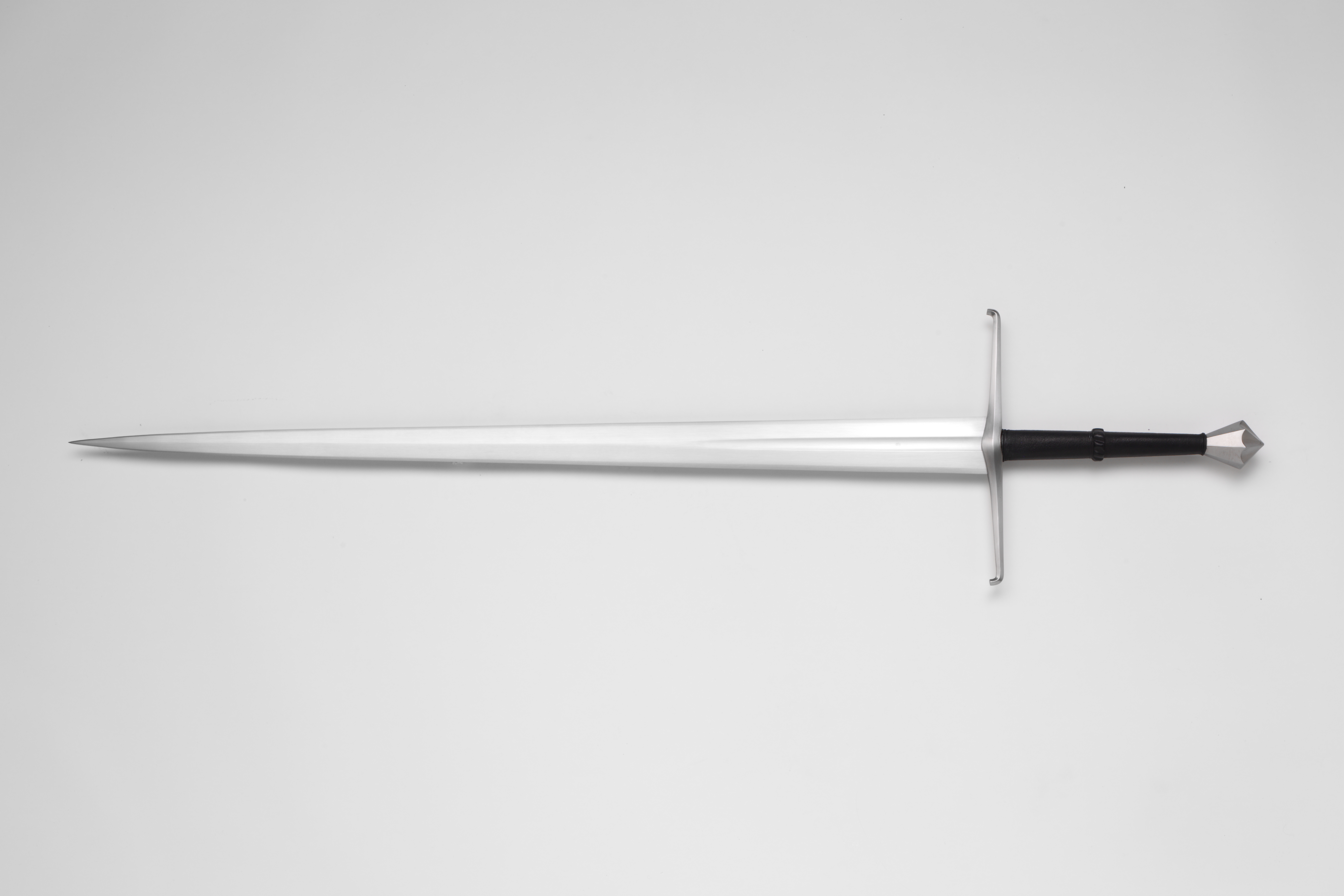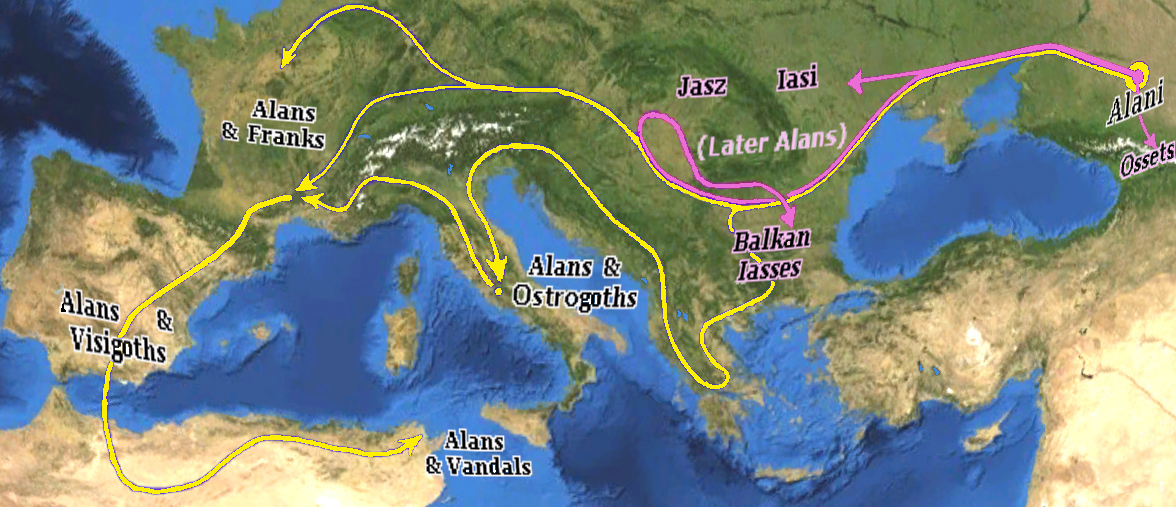|
Turko-Mongol Sabre
The Turco-Mongol sabre, alternatively known as the Eurasian sabre or nomadic sabre, was a type of sword used by a variety of nomadic peoples of the Eurasian steppes, including Turkic and Mongolic groups, primarily between the 8th and 14th centuries. One of the earliest recorded sabres of this type was recovered from an Avar grave in Romania dating to the mid-7th century. Although minor variations occur in size and hilt, they are common enough in design across five centuries that individual blades are difficult to date when discovered without other context. These swords were likely however, already influenced by swords used by others, such as the various Chinese swords. These swords measured between in blade length and bore a gentle curve, leading to a pointed tip useful for thrusting. They were designed for use on horseback and neighboring peoples frequently encountered these blades at the hands of Turkic raiders. A common feature of the hilts was a bend just below the pom ... [...More Info...] [...Related Items...] OR: [Wikipedia] [Google] [Baidu] |
Sword
A sword is an edged and bladed weapons, edged, bladed weapon intended for manual cutting or thrusting. Its blade, longer than a knife or dagger, is attached to a hilt and can be straight or curved. A thrusting sword tends to have a straighter blade with a pointed tip. A slashing sword is more likely to be curved and to have a sharpened cutting edge on one or both sides of the blade. Many swords are designed for both thrusting and slashing. The precise definition of a sword varies by historical epoch and geographic region. Historically, the sword developed in the Bronze Age, evolving from the dagger; the Bronze Age sword, earliest specimens date to about 1600 BC. The later Iron Age sword remained fairly short and without a crossguard. The spatha, as it developed in the Late Roman army, became the predecessor of the European sword of the Middle Ages, at first adopted as the Migration Period sword, and only in the High Middle Ages, developed into the classical Knightly sword, ar ... [...More Info...] [...Related Items...] OR: [Wikipedia] [Google] [Baidu] |
Anatolia
Anatolia (), also known as Asia Minor, is a peninsula in West Asia that makes up the majority of the land area of Turkey. It is the westernmost protrusion of Asia and is geographically bounded by the Mediterranean Sea to the south, the Aegean Sea to the west, the Turkish Straits to the northwest, and the Black Sea to the north. The eastern and southeastern limits have been expanded either to the entirety of Asiatic Turkey or to an imprecise line from the Black Sea to the Gulf of Alexandretta. Topographically, the Sea of Marmara connects the Black Sea with the Aegean Sea through the Bosporus and the Dardanelles, and separates Anatolia from Thrace in Southeast Europe. During the Neolithic, Anatolia was an early centre for the development of farming after it originated in the adjacent Fertile Crescent. Beginning around 9,000 years ago, there was a major migration of Anatolian Neolithic Farmers into Neolithic Europe, Europe, with their descendants coming to dominate the continent a ... [...More Info...] [...Related Items...] OR: [Wikipedia] [Google] [Baidu] |
Arming Swords
In the European High Middle Ages, the typical sword (sometimes academically categorized as the knightly sword, arming sword, or in full, knightly arming sword) was a straight, double-edged weapon with a single-handed, cruciform (i.e., cross-shaped) hilt and a blade length of about . This type is frequently depicted in period artwork, and numerous examples have been preserved archaeologically. The high medieval sword of the Romanesque period (10th to 13th centuries) developed gradually from the Viking sword of the 9th century. In the Late Medieval period (14th and 15th centuries), late forms of these swords continued to be used, but often as a sidearm, at that point called "arming swords" and contrasting with the two-handed, heavier longswords. Though the majority of late-medieval arming swords kept their blade properties from previous centuries, there are also surviving specimens from the 15th century that took the form of a late-medieval estoc, specialised for use against mor ... [...More Info...] [...Related Items...] OR: [Wikipedia] [Google] [Baidu] |
Longswords
A longsword (also spelled as long sword or long-sword) is a type of European sword characterized as having a cruciform hilt with a grip for primarily two-handed use (around ), a straight double-edged blade of around , and weighing approximately . The "longsword" type exists in a morphological continuum with the medieval knightly sword and the Renaissance-era Zweihänder. It was prevalent during the late medieval and Renaissance periods (approximately 1350 to 1550), with early and late use reaching into the 11th and 17th centuries. Names English The longsword has many names in the English language, which, aside from variant spellings, include terms such as "bastard sword" and "hand-and-a-half sword." Of these, "bastard sword" is the oldest, its use being contemporaneous with the weapon's heyday. The French ' and the English "bastard sword" originate in the 15th or 16th century, originally in the general sense of "irregular sword, sword of uncertain origin", but by the mi ... [...More Info...] [...Related Items...] OR: [Wikipedia] [Google] [Baidu] |
Cumans
The Cumans or Kumans were a Turkic people, Turkic nomadic people from Central Asia comprising the western branch of the Cumania, Cuman–Kipchak confederation who spoke the Cuman language. They are referred to as Polovtsians (''Polovtsy'') in Rus' chronicles, as "Cumans" in Western sources, and as "Kipchaks" in Eastern sources. Related to the Pecheneg, they inhabited a shifting area north of the Black Sea and along the Volga River known as Cumania, from which the Cuman–Kipchaks meddled in the politics of the Caucasus and the Khwarazmian Empire. The Cumans were fierce and formidable nomadic warriors of the Eurasian Steppe who exerted an enduring influence on the medieval Balkans. They were numerous, culturally sophisticated, and militarily powerful. Many eventually settled west of the Black Sea, influencing the politics of Kievan Rus', the Kingdom of Galicia–Volhynia, Galicia–Volhynia Principality, the Golden Horde Khanate, the Second Bulgarian Empire, the Kingdom of Serbia ... [...More Info...] [...Related Items...] OR: [Wikipedia] [Google] [Baidu] |
Alans
The Alans () were an ancient and medieval Iranian peoples, Iranic Eurasian nomads, nomadic pastoral people who migrated to what is today North Caucasus – while some continued on to Europe and later North Africa. They are generally regarded as part of the Sarmatians, and possibly related to the Massagetae. Modern historians have connected the Alans with the Central Asian Yancai of China, Chinese sources and with the Aorsi of Ancient Rome, Roman sources. Having migrated westwards and becoming dominant among the Sarmatians on the Pontic–Caspian steppe, the Alans are mentioned by Roman sources in the . At that time they had settled the region north of the Black Sea and frequently raided the Parthian Empire and the South Caucasus provinces of the Roman Empire. From the Goths broke their power on the Pontic Steppe, thereby assimilating a sizeable portion of the associated Alans. Upon the Huns, Hunnic defeat of the Goths on the Pontic Steppe around , many of the Alans migrated w ... [...More Info...] [...Related Items...] OR: [Wikipedia] [Google] [Baidu] |
Hermitage Museum - 2015 Dec - IMG 2117
Hermitage, The Hermitage or L'Hermitage may refer to: Common uses * Hermitage (religious retreat), a place of religious seclusion * The Hermitage (Nashville, Tennessee), the estate of Andrew Jackson * The Hermitage Museum, Saint Petersburg Places Antarctica * Hermitage Peak (Antarctica) Australia * The Hermitage (Australia), a school in Geelong, Victoria * The Hermitage, Queensland, a locality in the Southern Downs Region * The Hermitage, Denistone, a historic house in Sydney * The Hermitage, Vaucluse, a historic house in Sydney * Upper Hermitage and Lower Hermitage, rural areas near Adelaide, South Australia * Parish of Hermitage, New South Wales Canada * Hermitage, Edmonton, Alberta * Hermitage-Sandyville, a town in Newfoundland * Hermitage Peak (British Columbia) * The Hermitage (Hamilton, Ontario), a historic house Denmark * Hermitage Hunting Lodge, a royal hunting lodge north of Copenhagen France * Crozes-Hermitage, a commune of the Drôme d ... [...More Info...] [...Related Items...] OR: [Wikipedia] [Google] [Baidu] |
Yatagan
The yatagan, yataghan, or ataghan (from Turkish ''yatağan''), also called varsak, is a type of Ottoman knife or short sabre used from the mid-16th to late 19th century. The yatagan was extensively used in Ottoman Turkey and in areas under immediate Ottoman influence, such as the Balkans, Caucasus, and North Africa. Description Although weapons with features similar to yatagan were in use from the ancient times, its relation to them and its place of origin remains unknown. R. Elgood suggests that the yatagan is not a weapon native to Central Asia or Persia and it was adopted by Ottomans through their conquests, probably in the Balkans. The yatagan consists of a single-edged blade with a marked forward curve and a hilt formed of two grip plaques attached through the tang, the end of the hilt being shaped like large ears. The gap between the grips is covered by a metal strap, which is often decorated. The yatagans (also called ''varsaks'', named after the Varsak Turkomans) ... [...More Info...] [...Related Items...] OR: [Wikipedia] [Google] [Baidu] |
Talwar
The talwar (), also spelled talwaar and tulwar, is a type of curved sword or sabre from the Indian subcontinent. Etymology and classification The word ''talwar'' originated from the Sanskrit Language, Sanskrit word ''taravāri'' () which means "one-edged sword". It is the word for ''sword'' in several related languages, such as Hindustani language, Hindustani (Hindi and Urdu), Nepali language, Nepali, Marathi language, Marathi, Gujarati language, Gujarati, Punjabi language, Punjabi, etc. and as () in Bengali language, Bengali. Like many swords from around the world with an etymology derived from a term meaning simply 'sword', the talwar has in scholarship, and in museum and collector usage, acquired a more specific meaning. However, South Asian swords, while showing a rich diversity of forms, suffer from relatively poor dating (so developmental history is obscure) and a lack of precise nomenclature and classification. The typical talwar is a type of sabre, characterised by a c ... [...More Info...] [...Related Items...] OR: [Wikipedia] [Google] [Baidu] |
Pulwar
The pulwar or pulouar () is a single-handed curved sword originating in Afghanistan. Origin The pulwar originated alongside other scimitar-type weapons such as the Arab Arab sword, saif, the Persian shamshir, the Turkish kilij, and the Indian talwar, all of them ultimately based on earlier Central Asian swords. Originally, the Khyber Knife (a type of short sword) served as the weapon of the common people while upper-classes could afford to import swords from neighbouring Persia and India. Over time, the Afghans combined characteristics of the imported swords and adapted it to create the pulwar. Most existing pulwars date back to the early 19th century. Characteristics Borrowing features from the swords of neighboring lands, the pulwar may be described as an Afghan version of the Indian talwar. Pulwar blades tend to be more elaborately fuller (weapon), fullered than those of the talwar. Some pulwar hilts were fitted to Iran, Persian blades which are slimmer and more curved and ta ... [...More Info...] [...Related Items...] OR: [Wikipedia] [Google] [Baidu] |
Mughal Empire
The Mughal Empire was an Early modern period, early modern empire in South Asia. At its peak, the empire stretched from the outer fringes of the Indus River Basin in the west, northern Afghanistan in the northwest, and Kashmir in the north, to the highlands of present-day Assam and Bangladesh in the east, and the uplands of the Deccan Plateau in South India.. Quote: "The realm so defined and governed was a vast territory of some , ranging from the frontier with Central Asia in northern Afghanistan to the northern uplands of the Deccan plateau, and from the Indus basin on the west to the Assamese highlands in the east." The Mughal Empire is conventionally said to have been founded in 1526 by Babur, a Tribal chief, chieftain from what is today Uzbekistan, who employed aid from the neighboring Safavid Iran, Safavid and Ottoman Empires Quote: "Babur then adroitly gave the Ottomans his promise not to attack them in return for their military aid, which he received in the form of the ... [...More Info...] [...Related Items...] OR: [Wikipedia] [Google] [Baidu] |








